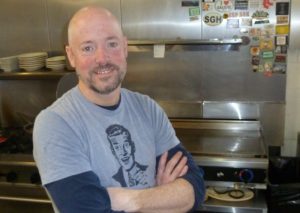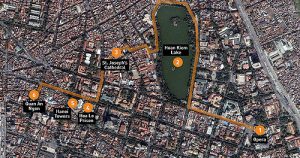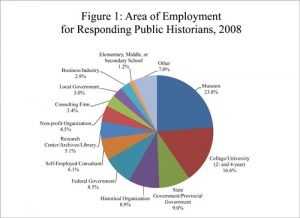
Image courtesy of the Metropolitan Nashville Archives and in the Public Domain.
PHYSICAL SITE:
In an article entitled, “Where the Soul of Nashville Never Dies,” author Jennifer Justus writes: “As Nashville undergoes a whiplash of change under a web of steel cranes, the Ryman stands sturdy among the neon and glass. Hallowed halls like ‘the mother church of country music’ can’t merely be built like a skyscraper or condo complex after all. They must become — painted with layers of experience and mystery over time. Try to uncover the meaning in their spirit by peeling back the paint, and you’ll only find another color, deeper and richer, worn in,” (Where the Soul of Nashville Never Dies).
The Ryman Auditorium is a special site of public history which plays multiple roles in showcasing Nashville’s history as Music City. The auditorium was originally constructed for as a tabernacle for religious services in 1892, but it quickly became the city’s go-to venue for hosting a wide range of performances, lectures, and events. Today a must-visit attraction for residents and tourists the Ryman Auditorium serves two purposes: museum by day and concert hall by night. I believe the Ryman serves a third purpose as a public history site, which is that the building itself is important and has undergone two major restorations since the 1990s. Its value as a conduit between local history and the public is immeasurable as the structure and what happened in that space (and the performances that continue) make public history not only interesting but relevant.
The original building exterior was brick and had a single front entrance for guests. It began as a theater in the round, but within thirty years a balcony and stage was added. When the building became the home of the Grand Ole Opry in the 1940s, the Ryman’s management, led by Lula Naff, added a backstage area to better accommodate performers and shows. Known as the “Mother Church” of country music, the Grand Ole Opry’s historic chapter at the Ryman came to a close in 1974 when it moved from 5th Avenue into new quarters at Opryland USA—a twenty-minute drive from downtown. One newspaper headline in 1974 read, “Minnie Cried,” referring to Sarah Cannon (better known as Minnie Pearl).
The Ryman entered a twenty-year period of abandonment, vandalism, and disrepair from 1974-1994, and developers discussed the property’s purchase and demolition. Not until Emmy Lou Harris performed at the Ryman in 1994 did the building regain positive recognition. Harris recorded a live album at the Ryman, which won many awards, and inspired many other country music legends to perform at the Ryman. The local community, in addition to high profile musicians, infused both life and renewed interest into the auditorium. This led to the larger of two restorations in 1995. Additional restorations and additions have allowed the Ryman and expand and enhance its exhibit space inside the theater while removing the introductory film, food/beverages, and gift shop to newer structures connected to the auditorium. Great care was taken to preserve the building’s historical integrity while also make it functional for continued used. For example, two doors were placed inside the framing of the original second story windows to allow access to the balcony. Guidelines for landmarks on the National Register also guided the restoration and renovation process.
There is a permanent exhibit featuring the collaboration and partnership between the Ryman and Hatch Show Print posters. This exhibit runs the length of the entire width of the building between the original exterior and the addition. A second permanent exhibit in the same space on the second floor had artifacts and a primary document collection related to the building and significant people who have performed or spoken at the Ryman. The list is extensive—from Booker T. Washington to Helen Keller to Elvis Presley. Current rotating exhibits in the include: “Workin’ on a Building,” “Showplace of the South,” Mother Church of Country Music,” “Inspired: 125 Years of Performance,” and “Ryman Renaissance.” The rotating exhibits are not large, because of the building’s multi-functional purpose, but they are impeccably curated and the museum exhibits’ layout (across the back and sides of the auditorium) also add educational elements to the already rich tour and spatial arrangement. In other words, the exhibits “lead” visitors through the museum portion of the auditorium while also creating a single flow of traffic. Interactive elements include video and QR codes for audio narration that can be pulled up on a patron’s personal mobile device. There are not assigned docents for self-guided tours but there are for tours that include the backstage area.
Still, there are guides available on both floors to answer questions and direct visitors. Given the functional duality of the building, I do not think the physical exhibit space could be any better organized or staged. In fact, I visited the Ryman last year, before the new exhibit spaces were completed, and I can attest to the effectiveness and efficiency of the exhibits today compared to previous displays. Prior the 2015 renovation, the Ryman had some small case exhibits that displayed memorabilia and a looped documentary about the buildings 1994-95 restoration. Today, there is an amazing new 3-D type film, entitled The Soul of Nashville, that encapsulates and sets up the building’s history and importance. Visitors begin their tour with this eleven-minute film before going into the actual space. The Ryman Auditorium today operates as serious museum by day, clearly dedicated to educating and presenting its history to the public.
The historical interpretation, artifacts, and text presented by the exhibits and their function within the space subtly but steadily reinforce the larger historical argument: The Ryman is the single most important symbolic space for music in Nashville, the South, and perhaps the nation (aside from Carnegie Hall which is the only other venue referenced in any of the exhibits or materials). I would have to agree that having toured the venue and its exhibits—the Ryman Auditorium does an exceptional job making this case to the audience. The audience is two-fold: 1) tourists and those not from Nashville and 2) Nashville residents of all ages from school groups to senior citizens. Nearly every Nashvillian knows of the Ryman, but many still do not know its history and its function as a museum and archive.
DIGITAL SITE:
In Jennifer Justus’s article, she also writes: “The Ryman is a physical emblem of the spiritual — a reminder that takes us beyond ourselves. But it also offers a comeback story of Nashville, saving a piece of its soul.” I would argue that a significant part of this most recent restoration and the effort to share the Ryman’s story has been digital. According to the museum’s director, Joshua Bronnenberg, Ryman Auditorium did not have an online public history presence (beyond a webpage that said museum tours existed) prior to 2016,
It is important to note that the digital public history elements are designed with the intention of luring web users to the actual museum. There are no primary source repositories or full-text documents. The digital site does offers several online exhibits that are excellent overall in terms of content and organization. One such online exhibit is a timeline. Each entry slides out from the side to connect to the chronological ordered years that run vertically down the center of the page. With many timelines or online exhibits the user can click on the entry box to access the full description, record, and any related images. This is not the case for the digital presence for the Ryman Auditorium. Granted the description text is pretty substantial for each timeline entry, but there is no full record or image attached.
Other online exhibits highlight four specific people or things connected to the Ryman’s history and success: Tom Ryman (main donor of building’s construction), Lula Naff (manager of the Ryman 40+ years), Hatch Show Print (which is associated with the Ryman and has an unofficial partnership but is a separate enterprise), and the Grand Old Opry (and its history as a live and recorded performance). All of the digital exhibits are nicely laid out, engaging, and create a logical “click-through” process of the site. The Ryman’s online presentation successfully delivers materials to its audience, which is mostly made up of people who hope or plan to visit the Ryman in-person. The digital site assumes that the audience is interested in country music and/or Nashville.
The Ryman’s digital presence also provides introductions for each of the rotating exhibits as well as a description and summary of each type of tour (self-guided, guided, backstage). A one-minute trailer for the amazing new eleven-minute film is also posted and can be viewed full-screen. While its content online differs from and cannot compare to the physical space, it succeeds in providing a general overview as well as specific spotlights to reach a larger audience online (ex. timeline). There are no online opportunities to interact with site creators beyond a general “Contact Us” page. However, given the Ryman’s many functions–it remains doubtful that an interactive online platform to connect visitors with the museum’s curators or archivists was desired. There is much that the Ryman Auditorium could do to make the digital experience more educational. However, given its purpose and scope, the digital experience is more than effective. After perusing several local sites to visit in person for this assignment; it was in fact the Ryman’s digital presence that made me want to invest the time and money required for admission. I must say, the $20 was well worth it, and I highly recommend visiting the Ryman Auditorium.
Sources:
Jennifer Justus, “Where the Soul of Nashville Never Dies,” Bitter Southerner, 2016, http://bittersoutherner.com/soul-of-nashville-the-ryman/#.WJst23qo3R0 (accessed February 7, 2017).
Ryman Auditorium Tours, 2016, http://www.ryman.com/tours (accessed February 6, 2017).
Ryman Auditorium History, 2016, http://www.ryman.com/history/ (accessed February 5, 2017).
“Photos of Nashville Theaters,” Metropolitan Nashville Archives, http://www.nashvillearchives.org/theater-photos.html (accessed February 8, 2017).









